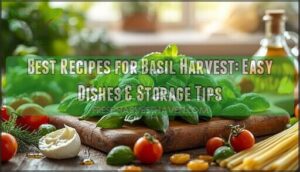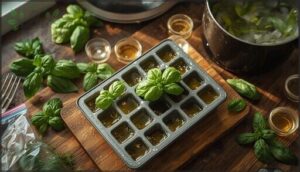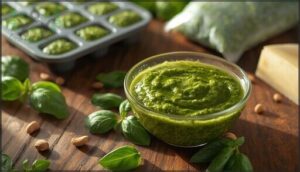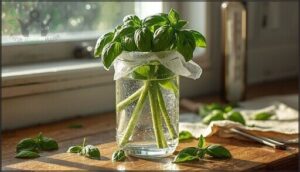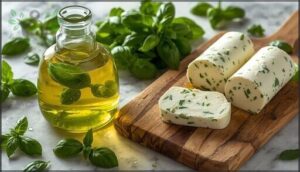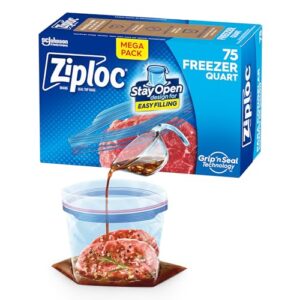This site is supported by our readers. We may earn a commission, at no cost to you, if you purchase through links.
Your basil plant exploded this summer. Now you’re staring at bushels of fragrant leaves wondering what to do before they wilt away. The good news? Fresh basil isn’t meant to sit in your fridge gathering regrets.
It’s meant to transform your cooking into something brighter, bolder, and way more interesting than you expected. From simple weeknight pastas that come together in one pot to elegant salads and showstopping mains that make basil the star, your harvest deserves recipes that match its potential.
You’ll also discover how to lock in that harvest magic for months, so you’re not scrambling next winter when you’re craving that fresh basil flavor you grew yourself.
Table Of Contents
Key Takeaways
- Fresh basil transforms weeknight cooking through simple one-pot pastas and creative salads that take 20-30 minutes, letting you use your harvest before it wilts while delivering restaurant-quality flavor without hours of work.
- Preserving basil through blanching and freezing in ice cube trays or making compound butter extends your harvest’s life up to six months, ensuring you’ve got that vibrant summer flavor waiting in your freezer during winter months.
- Pairing basil with unexpected ingredients like peaches, honeydew, or fennel creates showstopping dishes that prove fresh herbs aren’t just garnishes—they’re the star that ties sweet and savory flavors together in surprising ways.
- The right kitchen tools like a powerful food processor and proper freezer bags make the difference between wasting your harvest and efficiently preserving pounds of basil for year-round use in everything from pesto to infused oils.
Easy Basil Recipes for Every Harvest
When your basil plants are bursting with leaves, you want recipes that are simple but seriously delicious. These pasta dishes let that fresh basil flavor shine without making you spend hours in the kitchen.
Whether you’re cooking for picky eaters or trying something new, these recipes turn your harvest into meals everyone will love.
One-Pot Tomato Basil Pasta
Want dinner on the table in 20 minutes? One-pot tomato basil pasta is your answer. This family-friendly classic combines pasta, tomatoes, and fresh basil in a single pot, cutting cleanup dramatically. You’ll get around 330 calories per serving with solid protein and fiber.
The genius? All ingredients cook together, so flavors meld beautifully. For a richer flavor, consider using vegetable broth instead.
Whether you’re feeding a crowd or just yourself, this affordable recipe adapts easily—try adding spinach or swapping cheese types based on your taste.
Vegan Sun-Dried Tomato, Basil and Balsamic Bucatini
Ready to get fancier? Vegan bucatini with sun-dried tomatoes and balsamic vinegar is your next move. This decadent plant-based pasta delivers 500 calories per serving, packed with fiber and antioxidants.
Sun-dried tomatoes concentrate nutrients beautifully, while balsamic glaze adds elevated depth. Fresh basil brings that vitamin K punch you need. It’s trending hard in vegan recipes right now, and honestly? It tastes restaurant-quality but comes together faster than you’d think.
This dish is similar to a creamy, oil-free version that utilizes almond butter.
Broccoli Pesto Pasta
Now let’s turn up the flavor without breaking the plant-based bank. Broccoli pesto pasta transforms humble broccoli into a creamy, nutrient-dense sauce that’ll make you forget butter exists.
This homemade pesto recipe delivers serious nutrition:
- 60% of your daily vitamin C and 51% vitamin K per serving
- 3g of dietary fiber supporting digestive health
- Antioxidant-rich basil paired with broccoli’s plant protein
Whole wheat pasta amplifies the fiber content. Toss al dente pasta with your processed broccoli pesto, reserved florets for texture, and a splash of pasta water to smooth everything out. Restaurant-quality results, weeknight timing.
Creamy Sweet Corn Pappardelle
Summer’s sweetness meets creamy comfort in this vegan stunner. Wide pappardelle ribbons cradle corn sautéed until golden, then tossed with coconut milk, fresh basil, and a whisper of garlic. You’ll finish in under 30 minutes using just-picked farmers’ market corn and basil at peak flavor.
This seasonal showstopper adapts beautifully—swap coconut milk for ricotta, add gluten-free pasta, or dial up the sodium-conscious route with unsalted butter. Pure summer magic on a plate.
| Component | Amount | Cooking Time | Flavor Role |
|---|---|---|---|
| Pappardelle | 8 oz | 10 min boil | Tender base |
| Fresh corn | 2 ears | 5 min sauté | Natural sweetness |
| Fresh basil | 1/4 cup | Finish | Brightness |
| Coconut milk | 1 cup | 3-5 min | Creamy richness |
Kid-Friendly Basil Pasta Dishes
Kids consistently rank basil pasta among their favorite weeknight dinners—and for good reason. Skip the nuts and choose fun shapes like rotini or bowties to boost their interest.
Swap vegetables around for picky eaters, reduce sodium in your pesto, and get them cooking alongside you. When children help prepare basil pasta, they’re 20% more likely to actually eat it. That’s the real magic.
When children help prepare basil pasta, they’re 20% more likely to actually eat it—that’s the real magic
Fresh Basil Salads and Appetizers
When your basil harvest is piling up, salads and appetizers are where the magic happens. These recipes let your fresh basil shine without any heavy cooking, which means you can use it while it’s still at its peak.
Let’s explore some combinations that’ll turn your garden bounty into dishes that actually impress people.
Strawberry, Basil and Arugula Salad
Want to know why strawberry, basil, and arugula salad has taken over restaurant menus? This seasonal salad delivers over 100% of your daily vitamin C while keeping things light and invigorating. The peppery arugula, sweet berries, and aromatic basil create magic together—especially when you drizzle that strawberry-basil vinaigrette right before serving.
- Delivers 555 calories with 47g protein per main course serving
- Works beautifully as vegan adaptations with quinoa or tofu substitutes
- Pairs perfectly with goat cheese, pistachios, or candied walnuts
- Restaurant menus featured this 23% more from 2023 to mid-2025
Black Fig, Mozzarella and Basil Salad
This elegant salad variations showcase why figs and fresh basil are a chef’s dream pairing. With proper fig selection—ripe black mission figs work beautifully—you’ll create a stunning dish that combines creamy mozzarella with aromatic basil leaves.
The balsamic reduction ties everything together, delivering rich depth.
Serving suggestions include toasted pine nuts and prosciutto for extra flair. Your guests won’t believe this gourmet basil salad took just 15 minutes to assemble.
Tomato-Peach Caprese Skewers
Here’s where sweet meets savory in just five minutes. These Tomato-Peach Caprese skewers combine the best seasonal ingredients for an appetizer that’ll steal the show at any gathering.
What you’ll need:
- Fresh basil leaves (one per skewer)
- Cherry tomatoes for brightness
- Ripe peaches, cubed
- Fresh mozzarella balls
- Balsamic glaze for finishing
Thread them together, drizzle with oil, and watch your guests reach for seconds.
Honeydew, Feta, Jalapeño and Lime Salad
Ever wonder why fruit and savory herbs shouldn’t be best friends? This honeydew, feta, jalapeño, and lime salad proves they absolutely should be. The melon’s natural sweetness plays beautifully against creamy feta, while jalapeño adds that perfect kick. Fresh basil ties everything together in this delightful summer harvest recipe.
| Ingredient | Amount | Purpose |
|---|---|---|
| Honeydew | 4–5 cups cubed | Sweet base |
| Feta cheese | 3–4 ounces | Tangy contrast |
| Fresh basil | Up to 1 cup | Aromatic balance |
| Jalapeño | 1 small, sliced | Heat element |
| Lime juice | 2–3 tablespoons | Brightness |
Serve immediately for best texture and vibrant flavor.
Caprese Salad Variations
Caprese salad thrives on creative experimentation. You can swap traditional mozzarella for burrata or goat cheese, or go vegan with avocado. Try grilling tomato slices for smoky depth, or stack everything inside a hollowed tomato “cup” for visual drama.
Caprese skewers with cherry tomatoes work beautifully as appetizers. Adding pesto transforms the dish entirely. Each variation keeps that tomato and basil magic alive while delivering fresh nutrition and endless possibilities for your harvest.
Flavorful Basil-Based Main Courses
Now let’s move past the lighter appetizers and salads to dishes that really shine on your dinner table.
These main courses take fresh basil and pair it with proteins and bold flavors to create meals that feel special but don’t require hours in the kitchen.
You’re about to discover five recipes that prove basil isn’t just a garnish—it’s the star that ties everything together.
Skillet Roast Chicken With Peaches and Basil
When summer peaches hit their peak, this skillet roast chicken becomes your go-to weeknight champion. You’ll combine bone-in chicken thighs with fresh peaches, red onions, and tomatoes—it takes just 25 to 40 minutes total.
A handful of fresh basil finishes the dish, delivering roughly 380 calories and 27 grams of protein per serving.
The seasonal popularity peaks June through September, making this the definitive summer harvest recipe that’s surprisingly simple to master.
Grilled Peach, Chicken and Ricotta Pizza
Ready to level up from skillet cooking? This grilled pizza brings together caramelized peaches, tender chicken, and creamy ricotta for a showstopper that feels restaurant-quality but comes together in about 30 minutes total.
Here’s what makes it work:
- Basil pesto as your sauce base keeps things flavorful and simple
- Fresh basil added after baking preserves those essential oils
- Grilled peaches create natural sweetness that balances the savory elements
- Each slice delivers roughly 250-320 calories with 13-16 grams protein
This summer pizza trend isn’t slowing down—67% of home cooks are grabbing their homegrown basil for exactly this kind of recipe.
Baked Caprese Chicken Skillet
Want to keep things simple but impressive? This one-skillet wonder combines seared chicken with fresh mozzarella, ripe tomatoes, and—you guessed it—basil.
Prep takes just 10 minutes, then you’re baking at 350°F for about 30 minutes until your chicken hits 165°F internally. You’ll get roughly 31-34g of protein per serving with minimal carbs.
Drizzle balsamic at the end, garnish with fresh basil, and watch your dinner guests wonder why restaurant food tastes so ordinary by comparison.
Crispy Skillet Pizza With Fennel and Sausage
Now let’s crank up the heat with a cast-iron skillet pizza that’ll make your kitchen smell amazing. This one pairs fennel sausage with fresh fennel bulb—double the anise flavor, double the deliciousness.
Your skillet creates that restaurant-quality crust crispness you can’t get anywhere else. Top it with mozzarella, marinara, and fresh basil torn right before serving.
Twenty to thirty minutes total, and you’ve got Italian cuisine that tastes like you’ve been cooking all day.
Grilled Flatbread Pizza With Artichoke and Basil
With grilling temperatures exceeding 500°F, your flatbread pizza comes together in just 5 to 7 minutes. Here’s what makes this work:
- Choose lavash, Greek pita, or naan as your flatbread base
- Layer marinated artichoke hearts with ricotta or feta cheese
- Add fresh basil after grilling to heighten aroma
Drizzle with extra virgin olive oil and lemon zest. That timing trick—adding basil post-grill—keeps it vibrant and prevents it from burning. Your guests will taste the difference.
Preserving and Storing Your Basil Harvest
You’ve grown wonderful basil all season, and now comes the part where you make sure it sticks around. The good news is that preserving your harvest is way easier than you might think, and you’ve got several smart methods to choose from.
Let’s walk through the best ways to keep your basil fresh and flavorful all year long.
Freezing Basil for Year-Round Use
Freezing basil locks in your harvest’s magic for months ahead. Blanching benefits shine here—just dip leaves in boiling water for three to five seconds before freezing to preserve color and flavor. This nutrient retention trick beats storing raw leaves every time.
Proper storage duration reaches six months when you use airtight containers and minimize air exposure. Avoid common freezing mistakes like skipping the blanch step or leaving stems attached. Your garden’s bounty deserves better than blackened leaves and wasted potential.
Making and Freezing Basil Pesto
Making basil pesto transforms your harvest into liquid gold. A standard batch needs two cups of packed basil leaves and yields about one cup of finished pesto—enough for eight servings.
Pack those homemade pesto recipes into ice cube trays, then transfer frozen cubes to freezer bags for up to six months of storage. Add a thin olive oil layer on top before freezing to seal out air and preserve that vibrant green color.
Your pesto nutrient retention stays strong thanks to antioxidants in the oil and nuts working together beautifully.
Storing Basil With Proper Techniques
Want your basil to stay fresh longer? The secret’s in temperature control. Keep basil at 55°F—around room temperature—and it’ll last up to 10 days instead of turning black in your fridge.
Store stems upright in water, change it every few days, and loosely cover with plastic. Maintain humidity above 90% using a damp paper towel in a closed container.
Afternoon harvests also improve shelf life considerably compared to morning picks. These basil storage techniques guarantee year-round freshness from your harvest.
Preparing Basil Oil and Compound Butter
Once you’ve harvested your basil, transform it into shelf-stable treasures. Blanch leaves briefly to lock in that vibrant green, then blend with extra virgin olive oil for basil-infused olive oil that resists oxidation for weeks.
For compound basil butter, mix softened butter with finely chopped fresh basil, roll into logs, and freeze up to three months. Both methods preserve basil’s nutritional value and flavor brilliance far beyond the growing season.
Top Kitchen Tools for Basil Recipes
When you’re working with fresh basil, having the right tools in your kitchen makes all the difference. A good food processor, the right spatulas, and proper storage bags transform your cooking from messy to smooth.
Let’s look at three essential tools that’ll make prepping and preserving your basil harvest way easier.
1. Cuisinart Elite Collection Food Processor
When you’re processing pounds of fresh basil, you need a processor that won’t quit on you. The Cuisinart Elite Collection delivers 1,300 watts of quiet power paired with a 16-cup capacity—perfect for making pesto in one go. Its motor durability spans 20 years, while the SealTight lid prevents messy leaks when blending basil oils.
The nested bowl design offers processor versatility for both bulk and small batches. With dishwasher-safe parts and unmatched performance against pricier competitors, this machine justifies the investment for serious basil recipes and preservation work.
Best For: Home cooks and serious food enthusiasts who regularly work with large quantities of ingredients and want a processor that can handle everything from pesto to dough without breaking a sweat.
- Powerful 1,300-watt motor with a 20-year warranty and nested bowl design that handles both big batches and small jobs without cross-contamination
- Large 16-cup capacity processes pounds of fresh herbs or vegetables in one go, saving you time and effort in the kitchen
- Dishwasher-safe parts and a SealTight lid make cleanup easy, plus it’s quieter and more stable than pricier competitors
- Massive size requires significant storage space and may not fit under many kitchen cabinets
- At around $300, it’s a hefty investment if you only occasionally use a food processor
- Some users report minor inefficiencies with fine shredding tasks and occasional food waste around the disc
2. Silicone Spatulas Heat Resistant Baking Tools
While your food processor takes care of the heavy lifting, a quality silicone spatula becomes your best friend for folding, scraping, and mixing basil recipes. These heat-resistant tools withstand temperatures up to 500°F, making them perfect for basil-infused oils and warm cooking projects.
Their flexibility lets you get every bit of fresh basil paste from the bowl without waste. Unlike plastic alternatives, silicone resists staining and odor absorption, so your tools stay fresh season after season.
Dishwasher-safe and built to last 3-5 years, they’re an eco-friendly investment for any basil enthusiast’s kitchen.
Best For: Home bakers, cooks, and kitchen enthusiasts who want a durable, heat-resistant tool that won’t scratch non-stick cookware or absorb food odors and stains.
- Heat-resistant up to 500°F with food-grade silicone construction, making it safe for high-heat cooking, baking, and mixing hot ingredients without melting or leaching chemicals
- Flexible design allows you to scrape bowls and pans thoroughly, reducing waste and ensuring complete ingredient incorporation without scratching delicate surfaces
- Dishwasher-safe and built to last 3-5 years, resisting discoloration and odor absorption better than plastic or rubber alternatives
- The silicone may lack stiffness for some tasks, making it less effective at scraping hard or thick mixtures compared to firmer utensil options
- Quality control issues have been reported by some users, potentially affecting durability and performance despite the brand’s positive reputation
- Size limitations (11″L x 2″W) might feel too small or too large depending on personal preference and the specific mixing or cooking task at hand
3. Ziploc Quart Freezer Bags Stay Open
Now that you’ve prepped your basil, proper freezer storage keeps it thriving for months. Ziploc Quart Freezer Bags with their Stay Open design make freezing basil nearly simple—just fill without spilling, seal tight, and go.
The Grip ‘n Seal technology locks in freshness, while the 9 Points of Protection guard against freezer burn for up to six months. Portioning one to two cups per bag means you’re grabbing exactly what recipes need.
Best part? They’re reusable and microwave-safe, so your herb storage becomes genuinely convenient year-round.
Best For: Home gardeners, meal preppers, and anyone looking to preserve fresh herbs and frozen foods efficiently without hassle.
- Stay-open design with grip-and-seal technology makes filling easy and prevents spills during storage prep
- Reusable and microwave-safe for convenient thawing and reheating, plus they keep food fresh for up to six months
- Reliable freezer protection with 9 points of durability against freezer burn, tears, and damage
- Not recyclable in most programs, contributing to landfill waste if you’re environmentally conscious
- Some users report quality control issues with packaging and occasional difficulty opening the bags
- Bags aren’t recommended for reuse after storing raw meat, fish, or eggs, limiting their sustainability appeal
Frequently Asked Questions (FAQs)
What are the best companion herbs for basil?
Chives and basil make excellent garden partners, alongside mint and basil combinations. Oregano pairing works beautifully too.
These complementary herbs boost garden productivity while creating aromatic blends perfect for fresh recipes together.
How do you prevent basil from turning black?
To prevent chilling injury, keep your basil above 50°F and below 68°F. Store it with stems in water, covered loosely to maintain humidity.
Harvest in the late afternoon for better shelf life and disease prevention.
Can you substitute dried basil for fresh basil?
Like swapping a fresh tomato for sun-dried, you can substitute dried basil for fresh basil using a 1:3 ratio—one teaspoon dried replaces three teaspoons fresh—but expect more concentrated, earthy flavor and less vibrant culinary appeal.
Whats the ideal time to harvest basil leaves?
You’ll get the best flavor when harvesting basil in the afternoon or evening after plants reach six to eight inches tall. This timing maximizes essential oils and doubles shelf life compared to morning harvests.
How long does fresh basil last in refrigerator?
At ideal temperature (around 50°F), fresh basil lasts up to 12 days, but standard refrigerators cause chilling injury—expect just 3 to 7 days before you’ll spot browning, wilting, and flavor loss from humidity effects and packaging types.
Conclusion
Your basil plants aren’t going anywhere quietly. They’ll keep delivering those fragrant leaves until frost arrives, so keep them well-fed and happy.
Use these best recipes for basil harvest to turn every handful into something memorable, whether it’s a quick weeknight pasta or a showstopping main.
And when winter rolls around, you’ll open your freezer and find that green gold waiting, ready to brighten even the grayest days.

